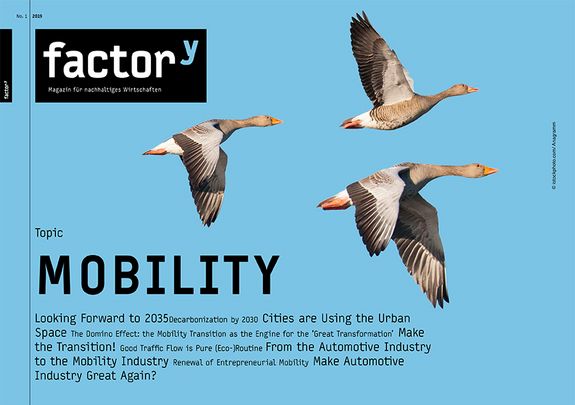Mobility

The strategies for changing cities range from a city congestion charge and free local transport to car-free days. Bicycle highways, streetcars and electric busses are also part of the strategy. Municipal administrations and urban economy can do a lot for the attractiveness of this range of options by creating their own transport transition, which is driven by the citizens.
By Thorsten Koska and Stephan Rammler. Translated by Julia Baur & Bianca Bauer.
Stuttgart, Berlin, Frankfurt, Cologne, Essen: In autumn of 2018, court judgments on driving bans in major German cities were issued almost weekly. For years now, the threshold limit values for nitrogen oxides have been radically exceeded. In order to put an end to this illegal situation, the Federal Administrative Court cleared the way in February 2018 for driving bans, which cities now have to implement gradually.
For years, politicians have turned a blind eye to the health-threatening air pollution caused by car traffic. For example, the Federal Government has shifted the responsibility for action onto the municipalities and blocked possible solutions — from a Blue Badge (a label for marking diesel vehicles) that is effective in the short term to the funds needed in the long term for better public transport. The municipalities have at best dared to make small changes to their transport policies— and hoped that newer vehicle technology would solve the problem on its own.
And the automotive industry, which contributed to the problem with its unlawfully high vehicle emissions, also continues to act as if it had nothing to do with the consequences. Instead, newly-sold cars are getting bigger, heavier and faster, while the number of vehicle registrations continues to rise. In the end, all of these players have shown at the diesel summits that they are not yet willing to take decisive action, but would rather limit themselves to symbolic policies.
Like under a magnifying glass, the current driving bans show the problems of urban traffic — and it is becoming clear that the pollution load is by far not the only challenge. The Federal Government states that in order for Germany to comply with the Paris climate goals, however, the CO2 emissions from traffic must be reduced by at least 40 percent by 2030. But while emissions are decreasing in all other sectors, greenhouse gas emissions from traffic are rising.
The Cost of City Traffic
Moreover, car traffic restricts the quality of life in cities and at the same time exacerbates the already growing social inequalities. Traffic noise makes living on main roads unattractive and unhealthy. Fast and dense traffic is dangerous — especially for the more vulnerable road users that do not travel by car. The high speed level as well as the lack of safe bike paths and sidewalks frighten off the cyclists and deprive the children of the ability to move freely around the city. It is because of these dangers that parents prefer to take their children to school by ‘parent taxi’, that is to say, by car. The lack of movement not only harms learning, but also makes it harder for children to participate independently in traffic later on.
Last but not least, car traffic takes up the spaces that cities are so urgently in need of. A stationary car occupies 12 square meters of public space that is provided almost free of charge; at a speed of 50 kilometers per hour, the car already takes up more than 100 square meters — space that is not available for green areas, street cafes and playgrounds.
This list shows that it is not enough to replace the dirty combustion vehicles with electric cars, thus ensuring an ‘energy transition in traffic’. Without a doubt, alternative drive systems can and must make a major contribution to reducing pollutants and CO2 emissions in the future. But in order to free the cities from gridlock and create livable environments with democratic mobility, this is not enough. We need a new paradigm for urban mobility, a transport transition.
The good life Is possible
An urban transport transition would increase the quality of life in the cities. Where cars still park today, green oases, street cafes and playgrounds can emerge tomorrow. There would be less noise and people of all ages could use the street space safely. Throughout the city, the speed limit would be 30 kilometers per hour. Instead of going by car, many more people would travel to work by other means of transportation. For instance, people could get to the train station using their own bike, take the city train from there and then, for the last kilometer, use one of the rental bikes that are to be found at every corner. The job ticket would be sponsored by the employer, making the changeover worthwhile for almost everyone. Another option could be the Bürgerticket (citizen ticket), a ‘semester ticket for everyone’. In future, autonomously driving minibuses could pick up the passengers and carry them from door to door where the bus and train connections are poor. And if you want a car for a trip to the lake or to do the weekly shopping, you can use car sharing.
Germany’s cities have a good chance of approaching such a transport transition and bring it to fruition, as they do not start from scratch, but have role models in many European cities who show how it can work.
There is Copenhagen, for example: The cityscape is dominated by cyclists and every third trip is taken by bike, as bike paths are wide, safe and the first to be cleared of snow, even before the streets. Moreover, cyclist get to enjoy the green wave at the traffic lights. Through ongoing encouragement and financial incentive, the former dominance in traffic of the car was reversed, and today even children and old people on bikes feel safe in the dense city traffic.
Then there is also Vienna, where one of the densest public transportation systems in Europe has been combined with an unrivalled low-cost ticket — for EUR 365 a year, i.e. one euro a day, citizens are mobile within the metropolis using public transport. This way, the share of public transport has doubled within 20 years.
And London avoided the gridlock by using a mixture of carrot and stick: A dense network of bike rental stations as well as new bike paths made leaving the car behind more appealing. If you would still like to drive into the city by car, you have to pay a city congestion charge.
With a little imagination it is possible to envision how a transport transition is possible in German cities, too. The prerequisite for this is the consistent implementation of what has so far only functioned on a small scale. Mobile Internet allows for mobility to be organized as a service that is available from everywhere and on the go. Car sharing, rental bikes and on-demand driver services enable intermodal mobility, i.e. mobility that comprises various means of transportation. This eliminates one of the greatest emotional arguments in favor of the car — the freedom to decide yourself when and how to get from A to B can be experienced with a smartphone as a Mobilitätsassistent (mobility assistant) instead of with a car key in your hand. Mobility stations are enabling the switchover — with charging points of electric car-sharing vehicles, secure and weather-protected bicycle parking, parcel collection points and much more.
Redistributing the space
To make this possible, cities have to set firm objectives — and then pursue them consistently. A bike path is only as secure as its weakest point, and if it ends abruptly at the road after 100 meters, many people prefer not to use their bike. And what use is there in a dense network of streetcars and car-sharing vehicles in the city center when in the residential area on the outskirts only one bus stops per hour and no car-sharing options are available? Cities have to not only spend money, but also set conditions for new mobility providers, so that their innovative transportation concepts reach all citizens. If that is done successfully, current car companies also have the opportunity to secure their future as mobility service providers with new business models.
However, new and better offers of EcoMobility alone, which includes cycling, public transport, walking and car-sharing, are not enough. After many decades of car-friendly urban planning, preference given to cars in street space and financing of car traffic, today it is still very attractive to use a private car. Here again, urban policy must have the aim to use not only pull factors that increase attractiveness of EcoMobility but also — admittedly, unpleasant — push factors that decrease the attractiveness of using a car.
Some of these instruments are already in the cities’ own hands. They can redistribute street space, reduce traffic lanes for cars and allocate them for bicycle traffic. And they can make a charge for parking in order to achieve, at least to some degree, true-cost pricing in the highly subsidized public parking space. In doing so, good interaction between the different measures is important. If alternatives to cars are promoted and developed, it may be easier for road users to accept that parking spaces and traffic lanes are reduced and prices for parking are raised.
Policy makers must emancipate themselves from the car
As important as these measures of municipalities in cooperation with new mobility providers are, the transport transition cannot be successful without any help from federal policy making, as many of the privileges of car traffic are established at the federal level. It starts with fiscal policy, as the special treatment for official vehicles makes it still possible to deduct vehicles that are highly motorized in an absurd way from taxes as operating materials, and as diesel fuel continues to be subsidized. And it is similar with regulatory law, where traffic regulations make it impossible to introduce a general speed limit of 30 kilometers per hour in cities and where the law on transportation of passengers hinders the implementation of innovative concepts of mobility that are a combination of busses, car-sharing and taxis. After all, it is the German Federal Government that constantly torpedoes stricter CO2 limits for cars at the EU level — in an attempt to protect the automotive industry and with the effect of endangering its transformation and therefore its sustainability.
If the transport transition has so many advantages and offers prospects even for the automotive industry to renew itself — why has nothing been done yet? First, policy makers are apparently afraid of drivers as voters who might perceive an eco-friendly transport policy as a threat. However, there are a number of reasons not to be afraid of that. In fact, people want livable cities, and where they witness the transport transition, like in Vienna, Copenhagen, Paris or London, they are satisfied with their local politicians.
Second, decades of support to the automotive industry have left behind corresponding structures, routines and ways of thinking in the administration, whether it be in planning agencies or ministries. In order to overcome them, it needs pressure from within and from outside. In 2017, Berlin citizens showed with the Bicycle Referendum how this is possible. With a bottom-up mobilization, they organized a citizens' initiative that demanded a radical transport transition. It was only after feeling this pressure that the city introduced the Berlin Mobility Act in mid-2018. The Act said that — for the first time in Germany — the priority given to EcoMobility over cars was not only described as a noble objective, but made legally binding.
Even though policy makers are not taking action yet — or maybe for this very reason —, a bottom-up transport transition is possible, if citizens take matters into their own hands.
Thorsten Koska is a political scientist and sociologist and works as a project leader in the area of energy, transport and climate policy at Wuppertal Institute. Stephan Rammler is the founding director of the Institute for Transportation Design (ITD) and professor for Transportation Design & Social Sciences at the University of Fine Arts in Braunschweig. Since October 2018, he has been the director of the Institute for Future Studies and Technology Assessment (IZT) in Berlin. The second edition of his book Volk ohne Wagen (a people without cars) was published in 2017 by Fischer Publishing House. In 2018, oekom Publishing House issued Der blinde Fleck der Digitalisierung: Wie sich Nachhaltigkeit und digitale Transformation in Einklang bringen lassen (the blind spot of digitalization: how sustainability and the digital transformation can be reconciled), which he had written together with Felix Sühlmann-Faul.
More articles on the topic of mobility and transport transition you will find in our correspondent factory-magazine Mobility. This you can download free of costs and it is pleasantly readable on screens and tablet-computers. As every time it is also nicely illustrated and contains all articles in the compact tablet-format plus appropriate numbers and citations. Online in our topics section a few articles are also available – there you can comment and rate them.
Beiträge online
MOBILITY

- Decarbonization by 2030
- Cities Use the Space
- The Domino Effect: the Mobility Transition as an Engine for the ‘Great Transformation’
- Mach die Wende!
- Guter Verkehr ist reine Ökoroutine
- Von der Automobilindustrie zur Mobilitätsindustrie
Themen
- The Domino Effect: the Mobility Transition as an Engine for the ‘Great Transformation’
- Cities Use the Space
- Decarbonization by 2030
- The fear of biting the hand that feeds you
- Where investing is a pleasure
- Why divestment is going to change the world
- A Robin Hood tax for climate protection
- May the Force Be with Us
- Modern Strategies
- The prerogative of interpreting the future now lies with the companies involved in climate protection”
- From Negotiating to Trading Equitably
- Can a donkey be tragic?
- Rethink rather than rebound: a sufficiency revolution must precede the efficiency revolution
- On Rebound, Prebound and Performance Gaps
- So Let Us Seize Power Then!
- With Common Property Against Political Failure
- So Let Us Seize Power Then!
- The Comforting Beauty of Failure
- “It Is Not Impossible at All.“
- Resource-light shopping
- Men Have Not Stopped Giving the Advantage to Women – So Far
- Toothpaste for Princesses and Soup for Pirates
- It is about equality
- A nice day
- Initiative instead of frustration
- The right ingredients
- Resilient for Life
- Not only, but also
- Appreciation – more please!
- Worth more than money
- Learning to value the value of goods
- Worth and Values
- The Transformative Power of Science
- Historically effective: How innovation and technology transform
- The Disappearance of Products
- Growing Older 101
- Columbus’ Egg
- It Works! In Theory at Least ...
- What If...?
- Analysing Separately – Thinking and Acting Together!
- Let’s Break Away from Determined Breaking Points
- More Gold in Waste than in Mines
- The art of separation
- Should you really DIY?
- The Aesthetics of Do-It-Yourself
- Standing on One’s Own Feet
- From the handaxe to desktop fabrication
- Using Shares to Survive the Crisis
- When Citizens participate
- Possess to Participate
- The Right Growth at the Right Time
- Gunter Pauli and Blue Economy
- When Sustainability Grows
- How we treat Growth
- Illusions about Growth

